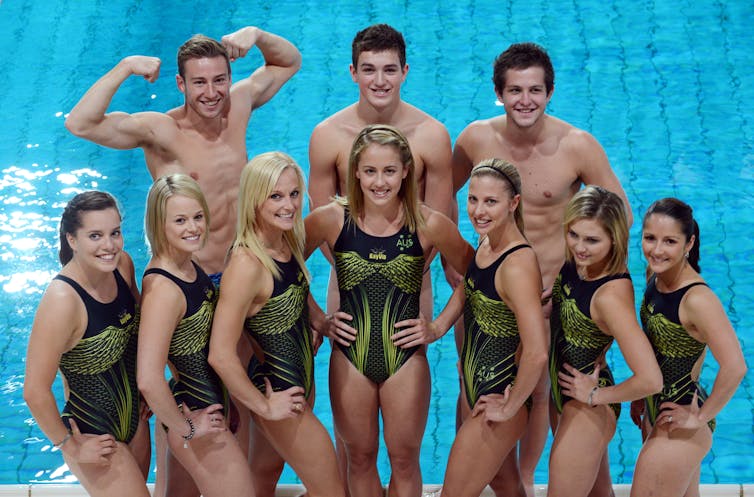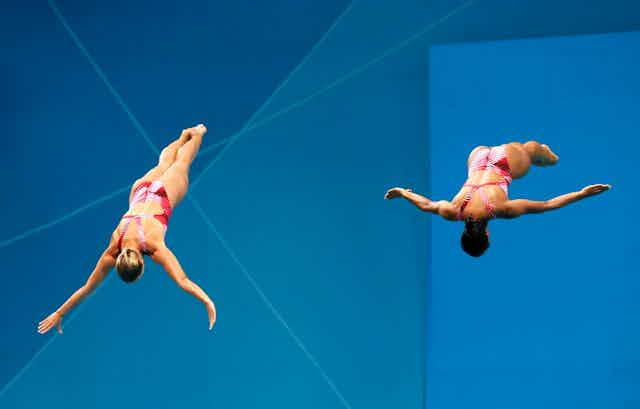Diving is one of the most graceful and spectacular sports in the world, and every four years, at the Olympics, it captures the attention of audiences worldwide. So what goes into the perfect dive?
Diving is physically demanding, requiring stamina and strength as well as speed, agility and flexibility to perform an incredible range of somersaults, pikes, and twists.
Many changes have occurred in competitive diving since its inclusion in the modern Olympics in 1904. Springboards which were once rigid wooden planks sloping upwards have undergone a radical transformation into tapered and perforated aluminium alloy boards mounted level and fitted with moveable fulcrums.
Training methods have become more sophisticated, with an emphasis on dry-land exercises and drills. The difficulty of dives performed in competition have also steadily increased during the last 30 years.
Where once, only a few elite competitors were capable of performing a forward 1½ somersault VID, dives such as a forward 4½ somersault are now being performed routinely. The video below, of Australian diver Ethan Warren, shows the front 4½ somersault being performed almost to perfection.
But just how do these athletes launch themselves from towers or springboards and disappear beneath the water with almost no splash?
At the moment of take-off from the platform or springboard, two critical aspects of the dive are determined, and cannot subsequently be altered during the execution. One is the trajectory of the dive, and the other is the magnitude of the angular momentum.
Because the initial conditions of the flight, specifically, the angle of projection at take-off, velocity of the centre of mass, and angular momentum, are established during the take-off, this phase plays a major role in determining the outcome of the dive.
During the take-off, divers must produce sufficient vertical momentum for the flight of the dive, adequate horizontal momentum to clear the take-off surface and enough angular momentum to execute the required number of twists and/or somersaults.
The success of the dive is determined by a combination of the divers’ position at last contact with the take-off surface and the magnitude and direction of the forces and that have been applied during the take-off phase.
Consequently, the success of a dive is largely dependent on the actions of the diver before they leave the take-off surface.

In the air, most dives are performed in a tucked or piked position. The tucked position is the most compact (body folded up in a tight ball, hands holding the shins and toes pointed), and as such, gives the diver the most control over rotational speed. Dives in this position, are therefore, easier to perform.
In a piked position the moment of inertia is larger (as the body has an increased radius) and consequently, the dives tend to have a higher degree of difficulty.
As the diver completes the required number of somersaults or twists, they open the body out ready for entry into the water. The action of opening out and changing body position does not stop the diver’s rotation, but merely slows it down.
The vertical entry achieved by expert divers is largely an illusion created by starting the entry slightly short of vertical, so that the legs are vertical as they disappear beneath the surface.
A good entry into the water in competitive diving is one which appears to be “splash-less”, is accompanied by a characteristic “rip” sound, and simulates the sound of tearing paper.
The rip entry, considered the “hallmark of a master” looks to a viewer as if the diver is being sucked into the water without a splash.
Australian Matthew Mitcham completed an Olympic-gold-winning “back 2½ somersault with 2½ twists in the pike position” at the 2008 Beijing Olympics. It’s an exemplary dive, with all of the characteristics mentioned above. You can watch it in this video at 1 minute 55 seconds in.
To achieve a rip entry, the diver’s arms must be extended forwards in line with the ears, the elbows must be locked and the stomach and back of the diver must be tight.
One hand grabs the other with palms facing down to strike the water with a flat surface. Impact with the water creates a vacuum between the hands, arms and head which, as the diver enters vertically, pulls any splash down and under the water with the diver until they are deep enough (1-2m) to have minimal effect on the surface of the water.

To be successful at international competitions, divers must be able to perform high degree-of-difficulty dives with reasonable consistency. To develop these skills, Australia’s top divers - among them Sharleen Stratton, Ethan Warren, Anabelle Smith and Brittany Broben - train 28-30 hours per week and split their time between the dry-land facility and the pool.
The dry-land training environment is a purpose built gymnasium next to the aquatic centre designed for land-based diving practice. The divers use this centre to warm up, for strength and conditioning skills, and to part-practise diving skills, where they can isolate small parts of the skill and practise them independently.
This might be the take-off and initial somersault before landing feet first on the mat or in the pit. In the pool, divers complete both feet first and traditional wrist first entries into the water.
Training programmes are written for each individual diver for each training session and cover basic water entries (to correct technique), take-off skills, compulsory dives (lower degree of difficulty dives performed in the preliminary rounds at competitions) and optional dives (dives with a higher degree of difficulty performed in competition).
Between each repetition, the athletes receive external feedback from the coach and delayed video replays of their performance from multiple angles, allowing them analyse their dives and constantly fine-tune the execution of these complex skills.
But these athletes don’t do it alone. Behind the divers are a team of dedicated coaches and support staff (trainers, psychologists, dieticians and analysts), who equally commit as many hours to training, sharing their experience and expertise to help these athlete in the pursuit of gold in London.


